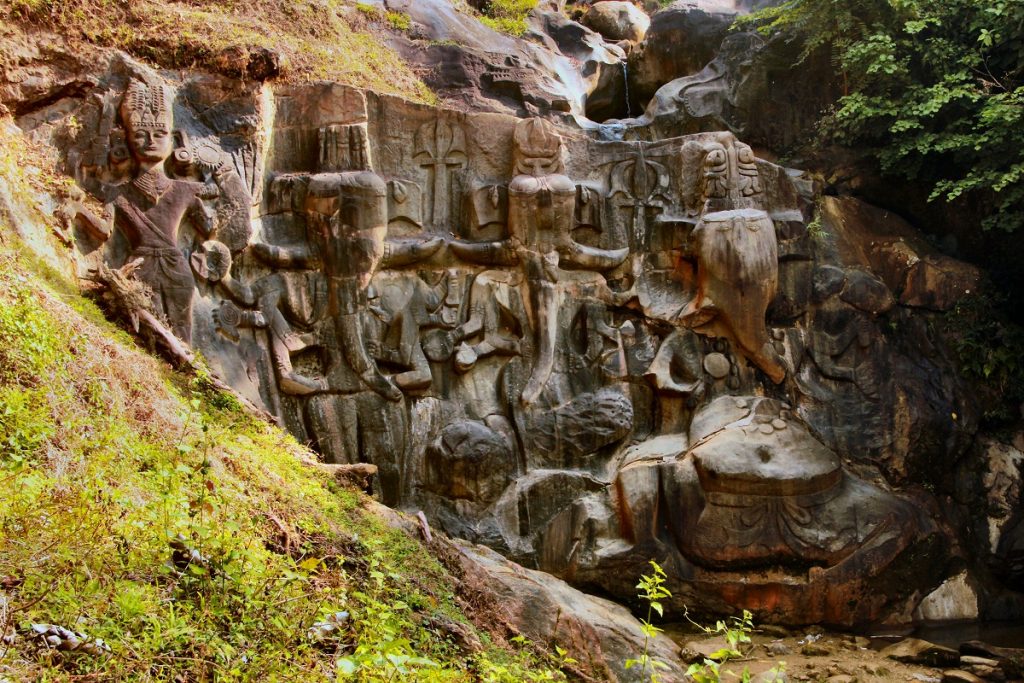Some places, though not remote, are off the tourist map. Surrounded by more illustrious and popular neighbours, these are usually overlooked. Tripura, despite its rustic appeal, rich history and culture, rare flora and fauna, and friendly locals is the least visited state of North East India. Sharing more than 800 km of border with Bangladesh, this non-descript Bengali speaking state has a few historical and architectural gems worth exploring.
Also Read: A Complete Guide to Exploring Tripura On Your Next Holiday
Unakoti

No one knows who carved numerous colossal Hindu God structures across large granite rock faces. Unakoti means “less than a crore,” indicating the exaggerated estimate of the number of Gods and Goddesses. Archaeologists estimate the carvings to date back to 11th-12th century A.D. with no certain theory about the architects. Most carvings being of Lord Shiva in varied forms indicates this place to be a Saivite Center flourishing during the Pala dynasty rule.

The bas-relief structures depicting huge Shiva heads are considered as the largest in size in India. Visit Unakoti to see the most striking figurines of three Lord Ganesha on a steep rockfall, downstream of a seasonal spring flowing right on their heads – giving it a bathing scene effect. Unakoti is a four hours’ drive from the state capital of Agartala.
Ujjayanta Palace
One of the finest architectural landmarks of the state, Ujjayanta Palace was built by Bubagra Radha Kishore Manikya Bahadur in 1901. Built using Indo – Saracenic style of architecture, it was the royal seat of Tripura kings. Now one of the largest museums of North East India, it covers an area of 800 acres, housing 22 galleries, more than 1400 collections of stone sculptures, terracotta plaques, copper plate inscriptions, sketches, oil paintings, and ornaments, all depicting the culture, tradition, history, art and lifestyle of various communities of the small state. Christened as ‘ Ujjayanta Palace’ by the famous Bengali poet Shri Rabindra Nath Tagore, it is surrounded by Mughal style gardens, water canals, ponds and fountains. The palace is closed to visitors on Monday and public holidays.
Neermahal

Situated in Western Tripura, this is the only lake palace in eastern India. Maharaja Bir Bikram Kishore Manakya, the then ruler of Tripura, gave the contract to a British company called Martin and Burn in 1930 to construct a summer place in the middle of Rudrasagar Lake – a deep and extensive wetland. It took 9 years to construct one of the finest epitomes of Indo-Islamic fusion architecture in Eastern India. Built majorly with marble and sandstone, it has numerous balconies, dome-shaped towers, extensive pavilions and bridges.

The beautiful red and white palace is divided into two parts. Arched doorways lead to the various domed and open terraces with an expansive view of the beautiful lake. Now almost in ruins due to neglect and ravages of time, one can’t help but wonder how the palace would have been in its glory days. Rudrasagar Lake has also shrunken by almost 40% in the last fifty years due to massive siltation caused due to deforestation in the catchment area and massive human intervention. However, the palace which is only accessible by a boat is one of the most popular destinations of Tripura with more than three lakh visitors every year. Neermahal is an hour’s drive from Agartala.
Kamaleswari Temple

Located adjacent to the Bangladesh border, it is one of the most sacred Hindu sites in Tripura. Dedicated to Lord Kali, it is thronged by lakhs of visitors every year. Revered as a ‘Shakti Peeth’, the temple structure is simple. The complex though crowded is clean and well maintained. Animal sacrifice is a common practice here. Built on the banks of Kamlasagar Lake whose other half lies in Bangladesh, it is also a famous picnic spot. Families with large lunch baskets and loud music are the usual visitors by the lakeside.
Sepahijola Wildlife Sanctuary
Spread across a small area of 14 sq km, the sanctuary houses many rare species of flora and fauna. The Clouded Leopard National Park is a part of the sanctuary and covers an area of 5 sq km. The place also houses a botanical garden, a zoo, a toy train and an artificial lake. It is home to some of the rare and endangered species of birds and animals. Thought to be extinct, the crab-eating mongoose was spotted here after 72 years in India. Bespectacled Langur, Pig-Tailed Macaque, Barking Deer, Monitor Lizards and the Clouded Leopard are few of the highlights of the sanctuary.
Home to more than 150 species of birds, especially during winter months, birds like the Red-Breasted Parakeet, Blyth’s Kingfisher and Greater Racket-tailed Drongo can be spotted in the sanctuary water bodies. Toy Train Rides and Boating are popular among families here. An hour’s drive from Agartala, keep a day for exploring the beautiful sanctuary. Permits are required for an overnight stay at the National Park.
Also Read: Visit These 5 Scenic Villages of Arunachal Pradesh
Have you been to Tripura? What were your experiences? Share them in the comments below!


